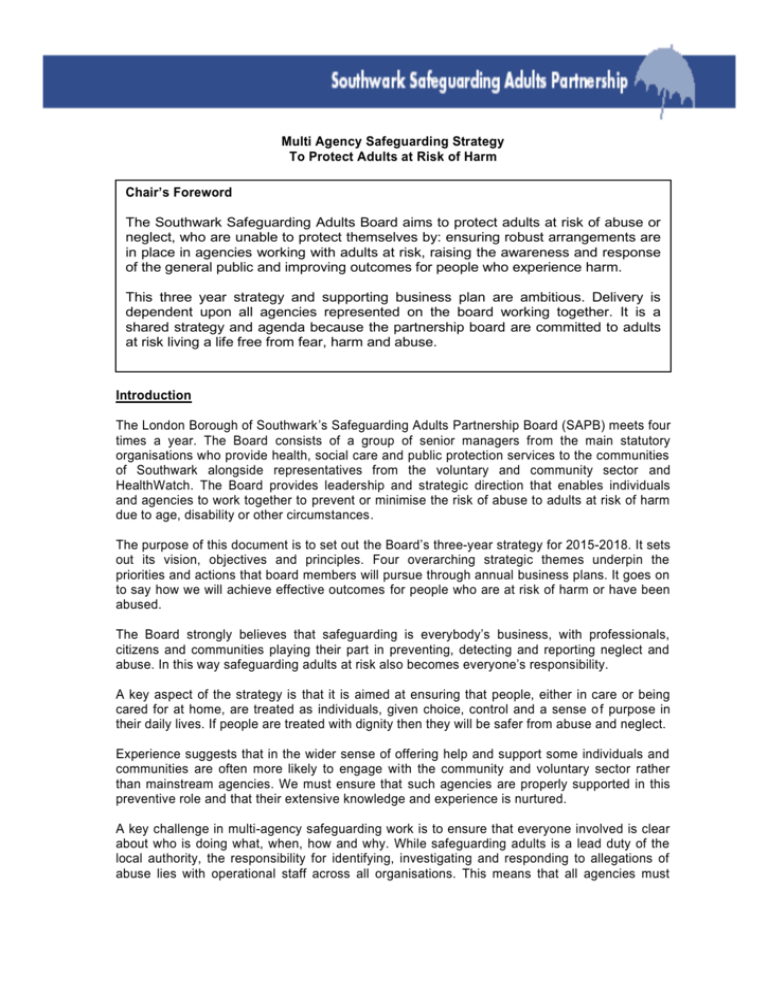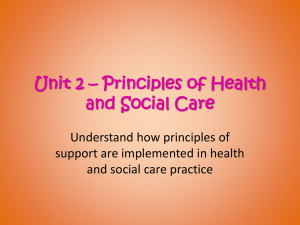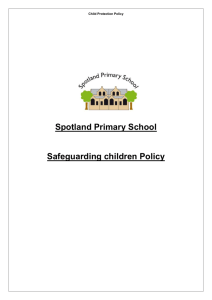Multi Agency Safeguarding Strategy to protect adults at risk of harm
advertisement

Multi Agency Safeguarding Strategy To Protect Adults at Risk of Harm Chair’s Foreword The Southwark Safeguarding Adults Board aims to protect adults at risk of abuse or neglect, who are unable to protect themselves by: ensuring robust arrangements are in place in agencies working with adults at risk, raising the awareness and response of the general public and improving outcomes for people who experience harm. This three year strategy and supporting business plan are ambitious. Delivery is dependent upon all agencies represented on the board working together. It is a shared strategy and agenda because the partnership board are committed to adults at risk living a life free from fear, harm and abuse. Introduction The London Borough of Southwark’s Safeguarding Adults Partnership Board (SAPB) meets four times a year. The Board consists of a group of senior managers from the main statutory organisations who provide health, social care and public protection services to the communities of Southwark alongside representatives from the voluntary and community sector and HealthWatch. The Board provides leadership and strategic direction that enables individuals and agencies to work together to prevent or minimise the risk of abuse to adults at risk of harm due to age, disability or other circumstances. The purpose of this document is to set out the Board’s three-year strategy for 2015-2018. It sets out its vision, objectives and principles. Four overarching strategic themes underpin the priorities and actions that board members will pursue through annual business plans. It goes on to say how we will achieve effective outcomes for people who are at risk of harm or have been abused. The Board strongly believes that safeguarding is everybody’s business, with professionals, citizens and communities playing their part in preventing, detecting and reporting neglect and abuse. In this way safeguarding adults at risk also becomes everyone’s responsibility. A key aspect of the strategy is that it is aimed at ensuring that people, either in care or being cared for at home, are treated as individuals, given choice, control and a sense of purpose in their daily lives. If people are treated with dignity then they will be safer from abuse and neglect. Experience suggests that in the wider sense of offering help and support some individuals and communities are often more likely to engage with the community and voluntary sector rather than mainstream agencies. We must ensure that such agencies are properly supported in this preventive role and that their extensive knowledge and experience is nurtured. A key challenge in multi-agency safeguarding work is to ensure that everyone involved is clear about who is doing what, when, how and why. While safeguarding adults is a lead duty of the local authority, the responsibility for identifying, investigating and responding to allegations of abuse lies with operational staff across all organisations. This means that all agencies must share a common understanding of what constitutes abuse, how to respond to an allegation and know what their responsibilities are. The Board will review governance arrangements and partner representation to take into account the Care Act, the integration agenda in the NHS, criminal justice agencies and other organisational changes. Our Vision Agreeing a clear vision shapes the Board’s strategy and goals. It helps us to set priorities and guides it when making difficult decisions. It unites the partners in achieving the overall goal to make Southwark a place where adults at risk can live a safe and independent life. VISION FOR ADULT SAFEGUARDING Southwark is a place where adults at risk of harm are able to live an independent life free from harm where: Abuse is not tolerated Everyone works together to prevent abuse Services respond effectively when abuse is suspected or happens. Our Objectives The Board’s objectives for the next three years are derived from the Statement of Government Policy on Adult Safeguarding (2013) and Safeguarding adults; a joint statement (2014) and they also draw upon national reviews and ourt initial consultation. To prevent abuse by training, awareness raising and information-sharing between member agencies To actively involve service users, their families and carers in improving safeguarding outcomes when working with adults at risk of harm For all agencies to deal swiftly and conclusively with any reported abuse and share lessons learned from investigations and reviews To agree and monitor a straightforward performance system that measures the effectiveness of the Board and holds its members to account Our Shared Commitments The following shared commitments will underpin the philosophy and working practice of all the Board’s partners. Each partner organisation will have zero tolerance of any kind of abuse to adults at risk of harm All members of the Board will work together collaboratively to safeguard adults at risk of harm from all forms of abuse, neglect and exploitation, whether by an individual or an organisation Each partner organisation will uphold their respective responsibility to safeguard people in accordance with the human rights principles of fairness, respect, equality and dignity Interventions by an appropriate safeguarding professional will be person-centred and undertaken with the intention of empowering people to make choices about their own independence, wellbeing and safety, including positive risk-taking Adults at risk of harm will be assumed to have the mental capacity to make decisions unless it is established that they lack capacity to make a specific decision Adults at risk of harm will be given full assistance to be involved in decision making and any decision taken on their behalf will be made in their best interests Partner organisations are accountable to the Board for ensuring that the principles, priorities and actions set out in this strategy are cascaded through and embedded within their organisation Our Strategic Principles Taking into account the recent research, such as the Statement of Government Policy on Adult Safeguarding released on May 2013 and advice together with the views of Board members, a number of principles were identified and agreed to support our Strategy. They are used to provide a framework to bring together and prioritise the various partner actions and initiatives. Empowerment – support for people to make their own choices about their lives. Prevention - it is better to take action before harm occurs. Proportionality – responses in proportion to the level of risk and in the least intrusive way. Protection - Support and representation for those in need. Partnership - Local solutions through services working with their communities. Communities have a part to play in preventing, detecting and reporting neglect and abuse. Accountability - Accountability and transparency in delivering safeguarding. The Principles are all of equal importance, though they are ordered in this document to highlight the importance of prevention and proportionate responses. Prevention of harm is always better than investigating harm that individuals have experienced, after the event. Empowerment and proportionality are critical in ensuring that individuals have the best experience possible when they are involved in safeguarding enquiries. Outcomes We Wish to Achieve Focusing on outcomes personalises safeguarding and entails working with people or their advocates from beginning to end of the process, while realising that their wishes may change along the way. People may generally want more than one outcome and these are frequently hard to reconcile; they often relate to both wanting to be safe and wanting to maintain unsafe relationships. However, we recognise that unless people’s lives are improved, then all the safeguarding work, systems, procedures and partnerships are purposeless The Board is committed to improving outcomes for people at risk of harm. Such outcomes concern those for the individuals we support and for the organisations represented on the Board. Individuals The Board consulted with individuals about the outcomes they would wish to see and the experience they would want to have when involved in a safeguarding episode. The business plan will be developed with these outcomes in mind. Empowerment – I am asked what I want as the outcomes from the safeguarding process and these directly inform what happens. Prevention -I receive clear and simple information about what abuse is, how to recognise the signs and what I can do to seek help. Proportionality -I am sure that the professionals will work for my best interests, as I see them and will only get involved as much as needed. Protection -I get help and support to report abuse. I get help to take part in the safeguarding process to the extent to which I want and to which I am able. Partnership – I know that staff treat any personal and sensitive information in confidence, only sharing what is helpful and necessary. I am confident that professionals will work together to get the best result for me. Accountability – I understand the role of everyone involved in my life. Where the principles are effectively applied, an individual would be able to agree with the following statements: People worked together to reduce risk to my safety and well being I had the information I needed; in the way that I needed it Professional helped me to plan ahead and manage the risks that were important to me People and services understood me -recognised and respected what I could do and what I needed help with The people I wanted were involved I had good quality care -I felt safe and in control When things started to go wrong, people around me noticed and acted early People worked together and helped when I was harmed People noticed and acted People asked what I wanted to happen and worked together with me to get it The people I wanted were involved I got the help I needed by those in the best placed to give it The help I received made my situation better People will learn from my experience and use it to help others I understood the reasons when decisions were made that I didn’t agree with Organisations Organisations’ experience of effective safeguarding is further explained below:- Empowerment We give individuals the right information about how to recognise abuse and what they can do to keep themselves safe. We provide clear and simple information about how to report abuse and crime and the support we can give. We consult with them before we take any action. Where someone lacks capacity to make a decision, we always act in his or her best interests. Protection We have effective ways of assessing and managing risk. Our local complaints and reporting arrangements for abuse and suspected criminal offences work well. Local people understand how we work and how to contact us. We take responsibility for putting people in touch with the right person. Prevention We help the community to identify and report signs of abuse and suspected criminal offences. We train staff how to recognise signs and take action to prevent abuse occurring. In all our work, we consider how to make communities safer. Proportionality We discuss with the individual and where appropriate, with partner agencies what to do where there is risk of significant harm before we take a decision. Risk is an element of many situations and should be part of any wider assessment. Partnership We are good at sharing information locally. We have multi-agency partnership arrangements in place and staff understand how to use these. We foster a “one” team approach that places the welfare of individuals before the “needs” of the system. Accountability The roles of all agencies are clear, together with the lines of accountability. Staff understand what is expected of them and others. Agencies recognise their responsibilities to each other, act upon them and accept collective responsibility for safeguarding arrangements. Next steps The strategy has set out the framework and direction for the next three years. It will be driven by the Board with key tasks against each of the objectives in an annual business plan which will be published and monitored At the end of each year the strategy will be reviewed, updated if necessary and a new business plan agreed for the following year.






